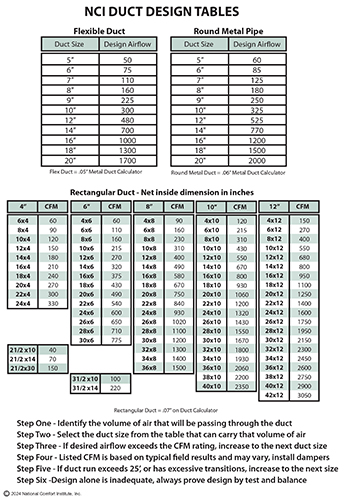Written for HVAC Professionals by HVAC Professionals
NCI Duct Design Tables

Sweet, simple, and on-point are the words I use to describe the NCI Duct Design Tables. Most technicians use untested and unverified methods when it comes to sizing ducts. Before you get angry, test and verify that the duct sizing method you use works.
If it does, disregard this tool review.
But if it doesn’t, check out what National Comfort Institute (NCI) put together years ago to improve duct sizing methods to help contractors and their customers increase safety, health, comfort, and efficiency.
The Duct Design Table customizes the .10-in. WC traditional friction rate to a real-world value of .05 for flex duct, .06 for round metal, and .07 for rectangular duct.
The applied friction rates allow maximum airflow to maintain the equipment manufacturer’s rated total external static pressure. It has some wiggle room built in just in case installation limitations may require a couple of extra turns.
Using the tables can be tricky, especially if it’s your first time. There are three different tables: one each for flex duct, round metal, and rectangular duct. So, be sure to use the right table. Duct sizes are listed from 5 to 20 inches for flex and round metal ducts and rectangular ducts from 4-in. x 6-in. to 42-in. x 12-in. and everything in-between. Each duct size will have a designated airflow.
When the airflow you need does not appear on the table, select the airflow greater than what is needed and add a damper during installation so you can throttle it down if necessary.
Whether designing a new system or a small air upgrade, the NCI duct design system is the way to go. It hasn’t failed me yet, and it shouldn’t fail you.
For more information, call your NCI Customer Care Representative at 800-633-7058.
— Casey Contreras, NCI Instructor













Recent Comments